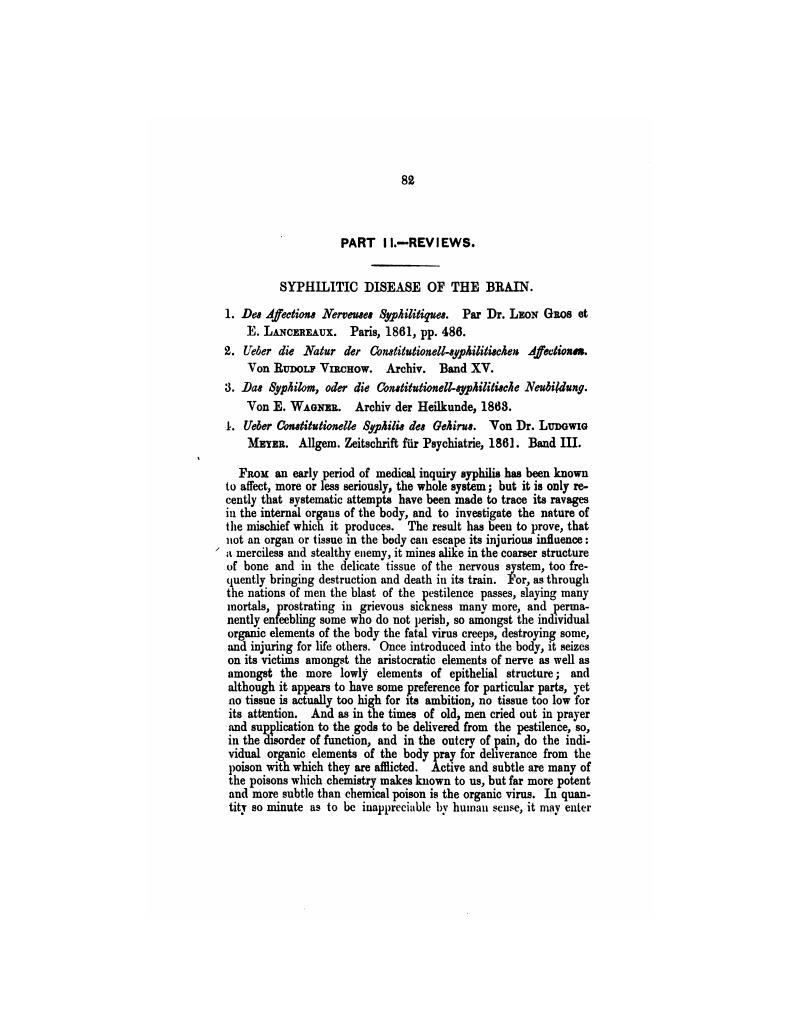No CrossRef data available.
Article contents
1. Des Affections Nerveuses Syphilitiques. Par Dr. Leon Gros et E. Lancereaux Paris, 1861, pp. 486. - 2. Ueber die Natur der Constitutionell-syphilitischen Affectionen. Von Rudolf Virchow. Archiv. Band XV. - 3. Das Syphilom, oder die Constitutionell-syphilitische Neubildung. Von E. Wagner. Archiv der Heilkunde, 1868. - 4. Ueber Constitutionelle Syphilis des Gehirus. Von Dr. Ludgwig Meter. Allgem. Zeitschrift für Psychiatrie, 1861. Band III.
Published online by Cambridge University Press: 19 February 2018
Abstract

- Type
- Part II.—Reviews
- Information
- Copyright
- Copyright © Royal College of Psychiatrists, 1864
References
∗ ‘Zeitschrift für Psychiatrie,’ xiv.Google Scholar
∗ In the ‘Allgm. Zeitsch. für Psychiatrie’ for 1863, Band xx, two cases of supposed syphilis of the brain are related by Dr. Westphal, of Berlin. The symptoms were those of gradually increasing paralytic dementia; and gummy formations, with partial softening, were met with in the brains.Google Scholar In an essay ‘Des Affections nerveuses Syphilitiques’ M. Zambaco reports some cases in which, after previous syphilis, the phenomena of paralytic dementia gradually appeared, and after death no gummy tumours, but the morbid changes usually met with in general paralysis were found.Google Scholar In the ‘Wiener Medizinal-Halle Zeitschrift,’ of February 21st, 1864, is the notice of a paper on “Syphilis of the Brain in relation to Insanity,” by Dr. Leidesdorf. He relates three cases in which constitutional syphilis existed,—in one case, with insanity, paralysis and epileptic attacks; in a second, there was insanity without paralysis; and in the third, there was hemiplegia without insanity. The insanity in the first case was dementia paralytica; in the second, it was fury passing into noisy dementia, which, though seemingly hopeless, was cured by iodide of potassium; the third, who finally died, had twice applied at the Klinik of Professor Oppolzer, and on each occasion had recovered under iodide of potassium. After death a tumour, considered to be syphiloma, was found at the base of the brain.Google Scholar
∗ This is not so certain as it has been represented to be; for it would appear that man's next of kin may suffer from syphilis. At the Manchester Medical Society, Mr. Lund exhibited the skull of a male monkey said to have died of syphilis. The bones were worm-eaten, as if from recent caries. During life the penis was extensively ulcerated, and the hair had fallen off in patches. A female, which had been confined with this animal, suffered from condylomata of the vulva and the anus. It was the decided opinion of the keeper that syphilis is communicated by the sexual intercourse of monkeys. (‘Brit. Med. Journal,’ Feb. 27.)Google Scholar





eLetters
No eLetters have been published for this article.